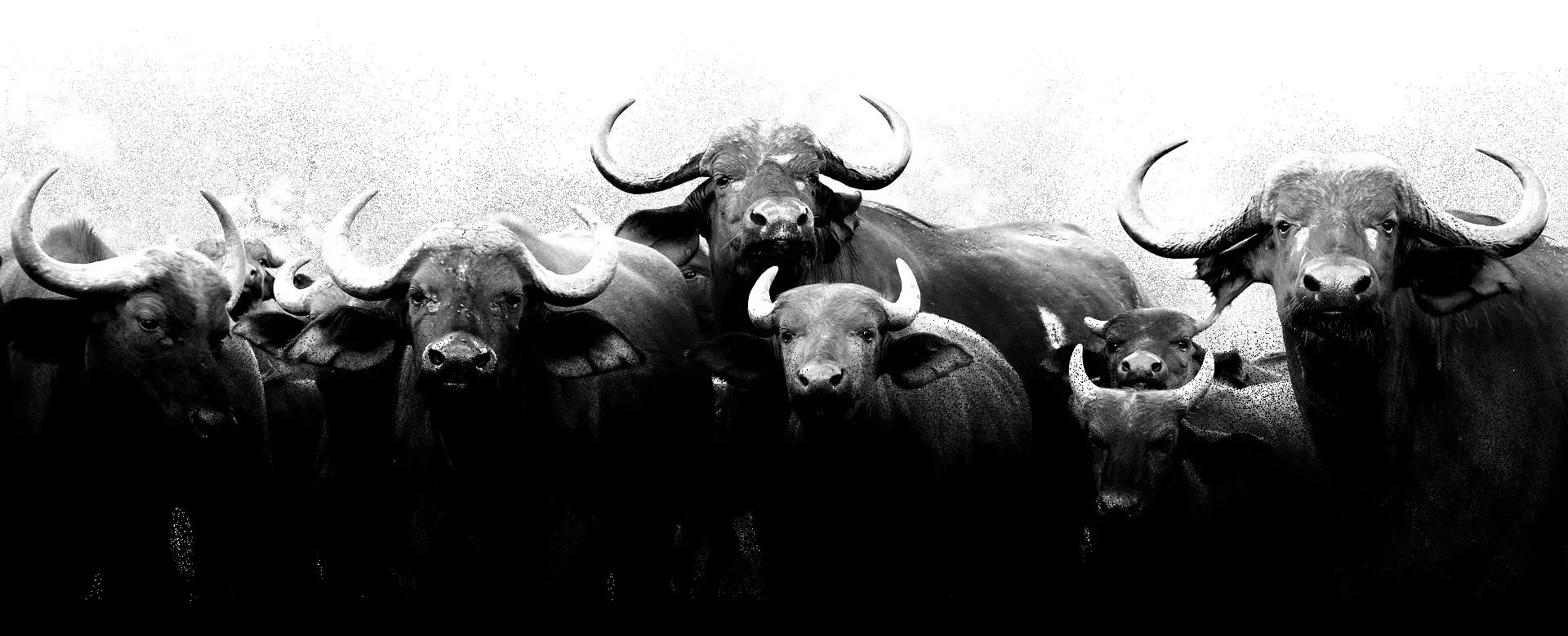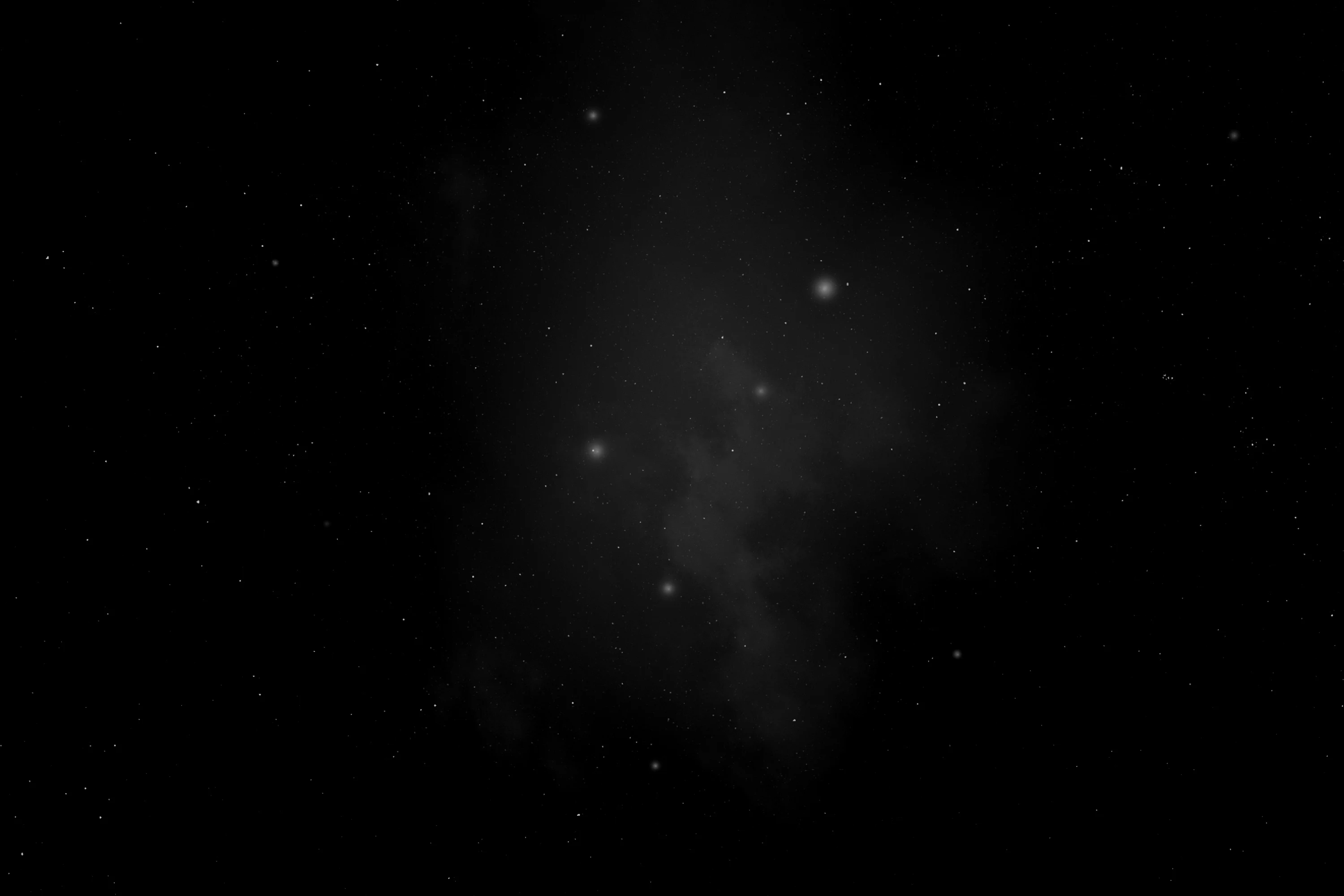
(Ursidae)
Bears
Ведмедеві
Bears are carnivoran mammals of the family Ursidae. They are classified as caniforms, or doglike carnivorans. Although only eight species of bears are extant, they are widespread, appearing in a wide variety of habitats throughout most of the Northern Hemisphere and partially in the Southern Hemisphere. Bears are found on the continents of North America, South America, and Eurasia. Common characteristics of modern bears include large bodies with stocky legs, long snouts, small rounded ears, shaggy hair, plantigrade paws with five nonretractile claws, and short tails.
Bears occur in nearly all terrestrial habitats throughout their range, from Arctic tundra and polar ice floes to tropical and temperate forests, mountains, grasslands, and deserts. Although some bear species occur in arid areas, proximity to water is important. Bears are most abundant and diverse in temperate and boreal regions. Most species are habitat generalists, changing preferred foods, activity patterns, and denning quarters with local conditions. Ailuropoda melanoleuca, however, is found primarily in the montane bamboo forests of southern China.
Physical Description
Bears are large, robustly built animals. The smallest species, Helarctos malayanus ranges in size from 25 to 65 kg, the largest individuals can weigh up to 800 kg (Ursus maritimus). Males are larger than females, sometimes more than twice their size. Bears have small, rounded ears, small eyes, and very short tails. Most species have long, rough fur, and the hairs that make it up are generally unicolored (rather than being agouti, the common pattern among mammals). Sun bears have a smooth coat. Most bears are brown, black, or white; some have striking white marks on the chest or face. Giant pandas are well-known for their distinctive bands of black and white fur. Bear skulls are massive, with unspecialized incisors, elongate canines, reduced premolars, and bunodont cheek teeth. All bear species possess robust, recurved, non-retractile claws that they use for digging and ripping. The feet of bears are plantigrade, and most have hairy soles, although tree climbing bears, such as Helarctos, have naked soles. There are five digits on each foot. Giant pandas (Ailuropoda melanoleuca) have an additional, opposable feature of the forepaws, sometimes called a panda’s “thumb”. It is not a true digit but a pad-covered enlargement of the radial sesamoid bone. Pandas use this opposable structure to manipulate bamboo.
The skulls of bears are elongated. They have an alisphenoid canal, and the paroccipital processes are large and not fused to the bullae, which are not enlarged. Curiously, the lacrimal bone of bears is vestigial. Their cheekteeth are bunodont, and the carnassials are flattened and specialized for crushing, not secodont. The incisors are unspecialized; the canines are long and slightly hooked; and the first three premolars are small and weakly developed if present at all. The dental formula is 3/3, 1/1, 3-4/4, 2/3 = 40-42.
Reproduction
Male and female bears generally associate only briefly for mating. Males monitor the estrus condition of females in their home range and will remain close for a few days when females are receptive. Multiple mating is practiced by both sexes.
Bears give birth to 1 to 4 young, usually 2, at intervals of 1 to 4 years. There is evidence of delayed implantation in all species. Gestation lengths ranging from 95 to 266 days, with implantation being delayed from 45 to 120 days. Actual gestation lengths may be closer to 60 to 70 days. Births in temperate species occur during the winter when the female is dormant. The cubs nurse during the dormant period and the entire metabolic demands of the female must be met by her fat reserves. Births in Helarctos malayanus may occur at any time of the year. Sexual maturity occurs at from to 3 to 6.5 years old, usually occurring later in males. Growth continues after sexual maturity. Males may not reach their adult size until 10-11 years old. Females reach adult sizes usually around 5 years old.
Females give birth to their young in protected areas, often a den of some kind, until they are capable of getting around well, at several months of age. Bears are very small when born, from 90 (Ailuropoda melanoleuca) to 680 (Ursus arctos) g at birth. They are born with their eyes and ears closed and are either naked or with only a fine layer of fur. Cubs grow rapidly, polar bears go from 600 g at birth to 10 to 15 kg within 4 months. Weaning occurs from 3.5 (Ursus thibetanus) to 9 (Ailuropoda melanoleuca) months. Young stay with their mother for up to 3 years, but young of most species disperse after 18 to 24 months. Females are very protective of their young and it is likely that cubs learn about obtaining food and shelter during their extended juvenile time with their mother.
Lifespan/Longevity
Bears are long-lived if they survive their first few years of life. Most mortality occurs in young cubs or dispersing juveniles as a result of food stress. Pre-weaning cub mortality was estimated at 10-30% in polar bears and sub-adult mortality at between 3 and 16%. In American black bears in Alaska, sub-adult mortality was estimated at 52 to 86%. Estimates of longevity in the wild are as high as 25 years. Captive animals have been known to live to 50 years or more (Ursus arctos).
Behavior
Bears are generally solitary, with the exception of mothers with their young. Bears are most often nocturnal or crepuscular, but may be active during the day as well. Polar bears (Ursus maritimus) are primarily diurnal. Bears generally take advantage of shelters, such as caves, hollow logs, and cavities in tree roots, as dens. Helarctos malayanus individuals spend much of their time in trees and build platforms for resting. Bears tend to move relatively slowly, with a shuffling, plantigrade gait, but are capable of running quickly when necessary, standing and walking on the rear two feet, and climbing. Polar bears (Ursus maritimus) are excellent swimmers and sun bears (Helarctos malayanus) are quite arboreal. Most bears move throughout a large range in order to meet their metabolic needs. Polar bear females migrate off of pack ice in late fall to give birth to their young in dens.
Some temperate bear species undergo extended periods of torpor during winters, retreating to underground burrows or caves to escape from temperature fluctuations. They become lethargic and metabolize fat reserves accumulated during the summer and fall. Some physiologists do not consider this a true state of hibernation, as body temperatures do not drop substantially and bears can be readily roused from this state. Others consider this distinction a semantic one and some researchers have proposed that this is a true hibernation because heart rates drop to almost half the normal rate. Bear species that undergo this form of hibernation often give birth during their winter sleep.
Communication and Perception
Vision and hearing in bears is not well-developed, but they have a keen sense of smell and use their sensitive lips to locate and maneuver food. Ursus americanus has color vision and has been demonstrated using vision to distinguish food items at close range. Little is known about communication in bears, but grunts, moans, and roars are known from most species. Cubs may be especially vocal, uttering “woofs” and shrill howls when distressed. “Chuffing” is used as a greeting in Ursus arctos. Chemical cues may be used by males in locating receptive females. Home range boundaries, individual identity, and sexual condition may be advertised, both visually and chemically, by tree-scratching and by urinating and defecating on boundary trails.
Food Habits
Bears are omnivorous and opportunistic. Specific food types may vary by habitat or season. For example, North American brown bears (Ursus arctos) may rely extensively on fruits and insect larvae throughout the year, or may prey extensively on calves during ungulate breeding seasons and on migrating fish. Most species eat primarily fruits and insect larvae but will include vertebrates when they can, carrion, honey, forbs and grasses, seeds, nuts, tubers, fish, and eggs. Bears use their formidable strength, massive forelimbs, and robust claws to tear apart logs and capture prey. Giant pandas (Ailuropoda melanoleuca) are dietary specialists, eating primarily bamboo stems and shoots, but will also include small vertebrates, insects, and carrion in their diet. Polar bears (Ursus maritimus) are the most carnivorous species, preying mainly on seal species, but including fish, small mammals, birds and their eggs, and will scavenge carcasses of whales, walruses, and seals.
Predation
Once bears reach their adult size it is unlikely that they will be subject to predation. Cubs are at risk of predation from conspecific bears, sympatric bear species, and other large predators, such as large cats and canids. Female bears are aggressive in defense of their young.
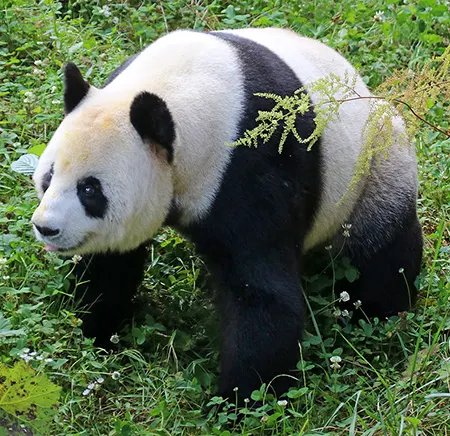
(Ailuropoda melanoleuca)
Giant Panda
Велика панда
It is endemic to China. It is found in small, fragmented populations in six mountainous regions in the country, mainly in Sichuan, and also in neighbouring Shaanxi and Gansu. It occurs at elevations of 1,200 to 4,100 m.
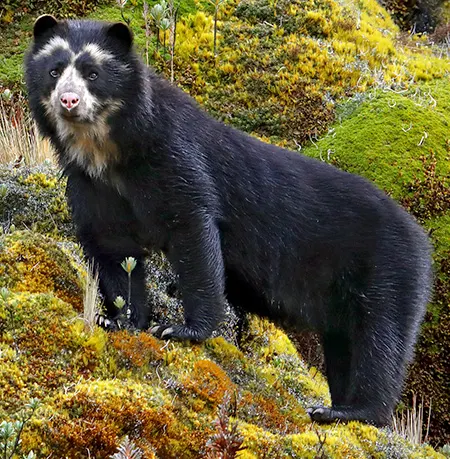
(Tremarctos ornatus)
Spectacled Bear
Очковий ведмідь
It is found in western Venezuela, Colombia, Ecuador, Peru, western Bolivia, and north-western Argentina. It lives mainly in montane forests on the western slopes of the Andes, at altitudes reaching up to 3,000 m.

(Melursus ursinus)
Sloth Bear
Ведмідь-губач
It is found in Bhutan, India, Nepal, and Sri Lanka. It occupies a wide range of habitats, including moist and dry tropical forests, savannas, shrublands, and grasslands. It occurs at elevations of up to 2,000 m.
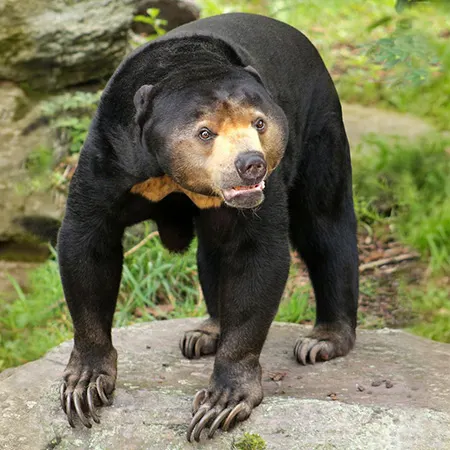
(Helarctos malayanus)
Sun Bear
Ведмідь малайський
It is native to the tropical forests of Southeast Asia; its range is bound by northeastern India to the north and extends south to Bangladesh, Myanmar, Thailand, Cambodia, Laos, and Vietnam to Brunei, Indonesia, and Malaysia to the south. It occurs at elevations of up to 2,100 m.
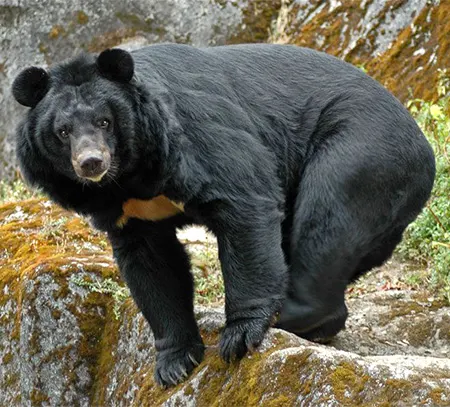
(Ursus thibetanus)
Asian Black Bear
Ведмідь гімалайський
It is found in hilly and mountain forests from Iran through Afghanistan, Pakistan and the Himalayas to Korea and Japan. Its northern range includes north-eastern China and Russia’s Primorsky Krai, while the southern range extends to northern Vietnam, Hainan, and Taiwan. In the Himalayas, it ascends to elevations of 3,000–4,000 m during summer.
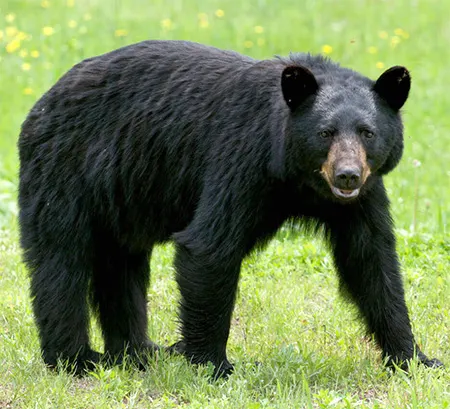
(Ursus americanus)
American Black Bear
Ведмідь барибал
It is found from northern Alaska and Canada southward to central Mexico, including the states of Nayarit and Tamaulipas, and ranges from the Atlantic to the Pacific coasts. It lives in various lowland and mountain forests at an altitude of 900–3,000 m.
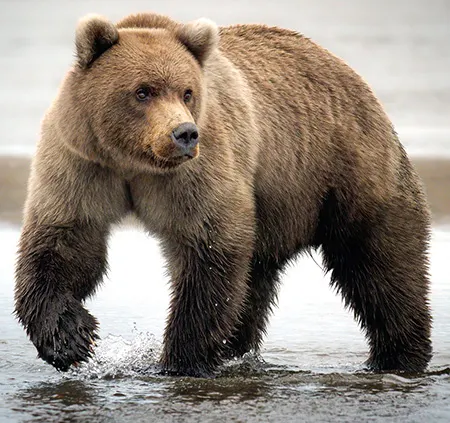
(Ursus arctos)
Brown bear
Ведмідь бурий
It is found from Western Europe and Palestine to Eastern Siberia and the Himalayan region, as well as in the Atlas Mountains of northwest Africa and on Hokkaido Island in Japan. Populations in northern North America, particularly in Alaska and western Canada, remain fairly stable.
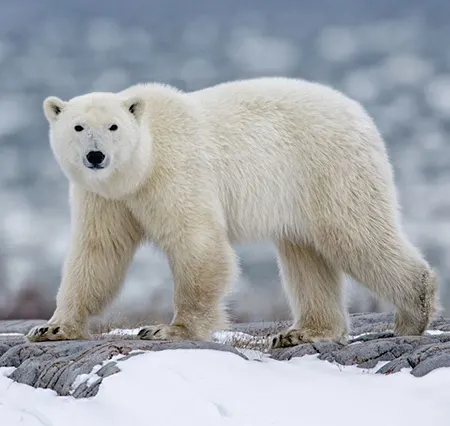
(Ursus maritimus)
Polar Bear
Ведмідь білий
It inhabits the Arctic and adjacent areas. Their range includes Greenland, Canada, Alaska, Russia and the Svalbard Archipelago of Norway.
